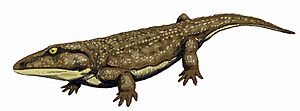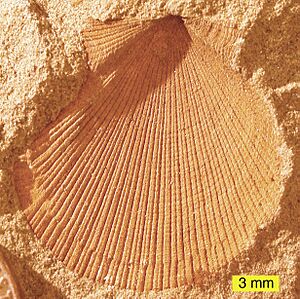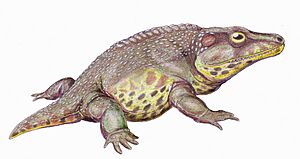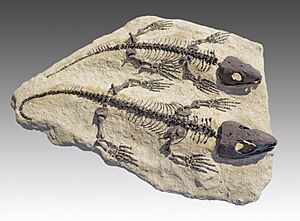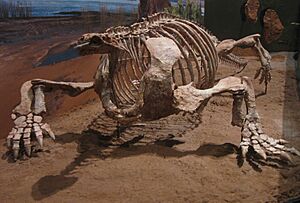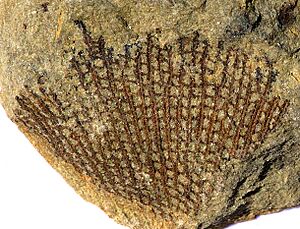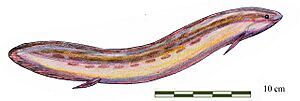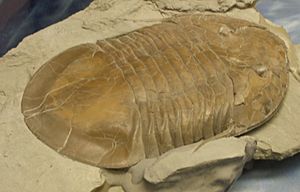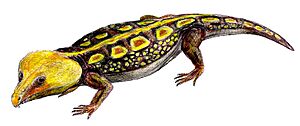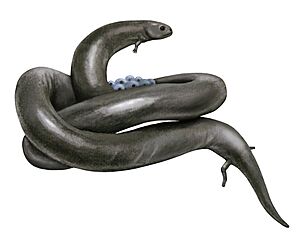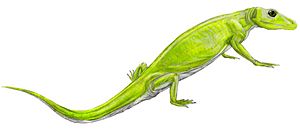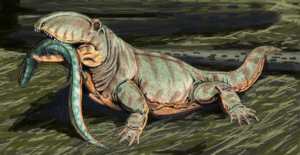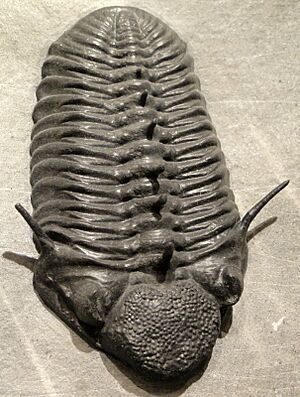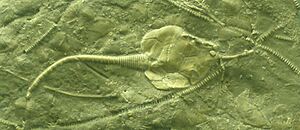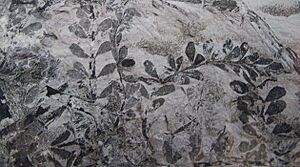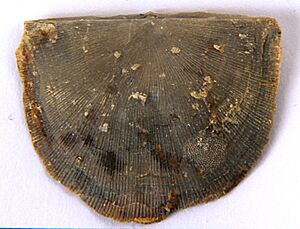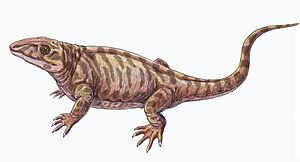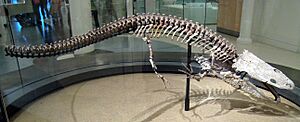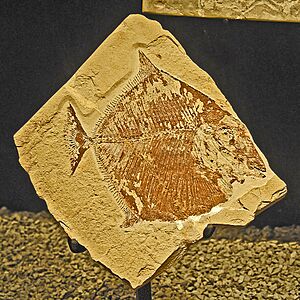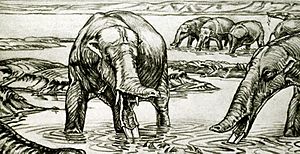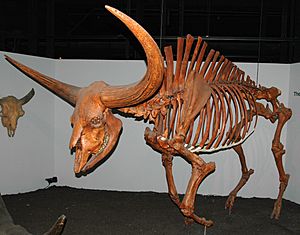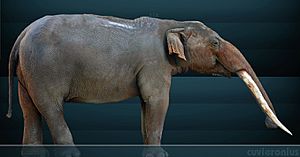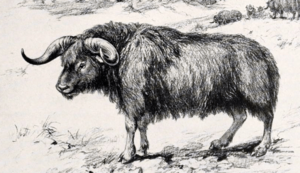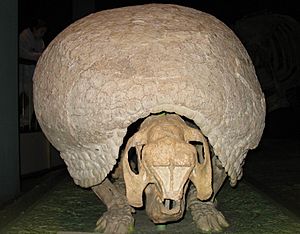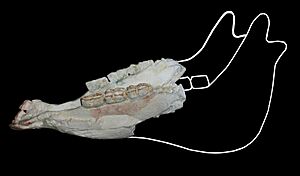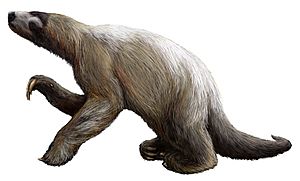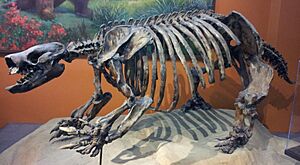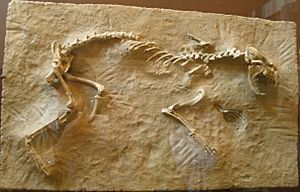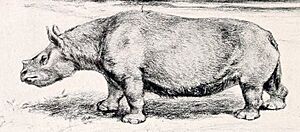List of the prehistoric life of Oklahoma facts for kids
The state of Oklahoma has a long history of amazing prehistoric life! Scientists have found many fossils here. These fossils tell us about the ancient plants and animals that once lived in this area. From tiny sea creatures to giant dinosaurs and huge mammoths, Oklahoma was home to many different kinds of life over millions of years.
Ancient Life of the Paleozoic Era
The Paleozoic Era was a very long time ago, from about 541 to 252 million years ago. During this era, Oklahoma was often covered by shallow seas. This means many of the fossils found are from sea creatures. Later, as the land rose, different animals and plants appeared.
Here are some of the cool creatures and plants from Oklahoma's Paleozoic past:
- †Abyssomedon was an early reptile. It lived during the Permian period.
- †Acheloma was an amphibian. It looked a bit like a salamander. It lived in the Permian period.
- †Acleistorhinus was another early reptile. It was quite small.
- †Annularia was an ancient plant. It was related to modern horsetails.
- †Archeria was an early amphibian. It had a long, eel-like body.
- †Archimedes was a type of bryozoan. These were tiny sea animals that lived in colonies. They formed spiral shapes.
- †Aspidosaurus was a type of amphibian. It had bony plates on its skin.
- †Aviculopecten was a type of ancient scallop. It lived in the sea.
- †Bolosaurus was a small, early reptile. It had a short, deep skull.
- †Cacops was a sturdy amphibian. It had strong limbs. It lived on land and in water.
- †Captorhinus was a common reptile. It was about the size of a lizard.
- †Cheirurus was a trilobite. Trilobites were ancient sea arthropods. They are now extinct.
- †Colobomycter was a very early reptile. It was found in Oklahoma.
- †Composita was a type of brachiopod. These are shelled sea creatures. They look a bit like clams.
- †Cotylorhynchus was a large, plant-eating animal. It was a synapsid, an ancestor of mammals.
- †Cyclopteris was a type of ancient fern. It had large, rounded leaves.
- †Delorhynchus was another early reptile. It was small and lived in the Permian period.
-
†Dimetrodon was a famous synapsid. It had a large sail on its back. This sail might have helped it control its body temperature.
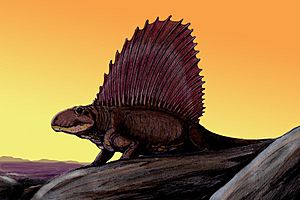 Life restoration of the Permian synapsid (mammal precursor) Dimetrodon
Life restoration of the Permian synapsid (mammal precursor) Dimetrodon - †Diplocaulus was a strange-looking amphibian. It had a boomerang-shaped head.
-
†Edaphosaurus was a plant-eating synapsid. It also had a sail on its back.
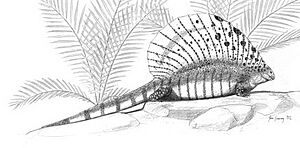 Life restoration of the Carboniferous-Permian synapsid (mammal precursor) Edaphosaurus
Life restoration of the Carboniferous-Permian synapsid (mammal precursor) Edaphosaurus - †Eryops was a large amphibian. It looked like a giant salamander.
- †Fenestella was a delicate bryozoan. It formed fan-shaped colonies.
- †Gnathorhiza was a type of lungfish. These fish can breathe air.
- †Isotelus was a very large trilobite. It could grow up to 70 cm long.
- †Labidosaurus was a sturdy reptile. It was one of the earliest reptiles.
- †Lepidodendron was a giant tree-like plant. It grew in ancient swamps.
- †Lysorophus was a snake-like amphibian. It had a very long body.
- †Mycterosaurus was a small, early synapsid. It was related to mammals.
- †Ophiacodon was an early synapsid. It was a meat-eater.
- †Paciphacops was another type of trilobite.
- †Pleurocystites was a type of ancient sea lily. It was related to starfish.
-
†Seymouria was a reptile-like amphibian. It was an important link in evolution.
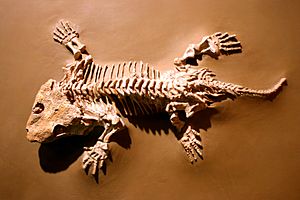 Fossilized skeleton of the Permian primitive four-limbed animal Seymouria
Fossilized skeleton of the Permian primitive four-limbed animal Seymouria - †Sphenophyllum was an ancient plant. It was related to horsetails.
- †Strophomena was a common brachiopod.
- †Varanops was an early synapsid. It looked like a lizard.
Dinosaurs and More from the Mesozoic Era
The Mesozoic Era, often called the "Age of Dinosaurs," lasted from about 252 to 66 million years ago. Oklahoma was home to many famous dinosaurs and other creatures during this time.
Here are some of the amazing finds from Oklahoma's Mesozoic Era:
-
†Acrocanthosaurus was a huge meat-eating dinosaur. It was similar to Tyrannosaurus rex. Its name means "high-spined lizard."
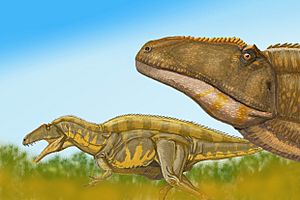 Life restoration of the Early Cretaceous theropod dinosaur Acrocanthosaurus
Life restoration of the Early Cretaceous theropod dinosaur Acrocanthosaurus - †Albanerpeton was a small amphibian. It looked a bit like a salamander.
- †Allosaurus was another large meat-eating dinosaur. It was a top predator in its time.
-
†Brontosaurus was a giant, long-necked plant-eating dinosaur. It was one of the largest land animals ever.
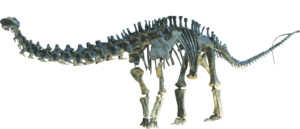 Mounted fossilized skeleton of the Late Jurassic long-necked dinosaur Brontosaurus
Mounted fossilized skeleton of the Late Jurassic long-necked dinosaur Brontosaurus - †Camarasaurus was a large, plant-eating dinosaur. It had a short, heavy skull.
- †Camptosaurus was a plant-eating dinosaur. It could walk on two or four legs.
-
†Deinonychus was a swift, meat-eating dinosaur. It had a large, sickle-shaped claw on its foot. It was a type of "raptor."
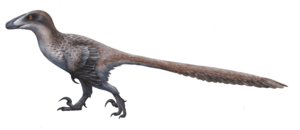 Life restoration of the Early Cretaceous dromaeosaur ("raptor") Deinonychus
Life restoration of the Early Cretaceous dromaeosaur ("raptor") Deinonychus - †Diplodocus was an extremely long dinosaur. It had a very long neck and tail.
- †Goniopholis was an ancient crocodile relative. It lived in freshwater environments.
- †Koskinonodon was a giant amphibian. It had a flat, broad head.
- †Palaeobalistum was a type of bony fish. It had strong, rounded teeth.
- †Saurophaganax was a very large meat-eating dinosaur. It was even bigger than Allosaurus.
- †Sauroposeidon was one of the tallest dinosaurs. It was a long-necked plant-eater. Its name means "lizard earthquake god."
- †Stegosaurus was a well-known plant-eating dinosaur. It had large plates on its back and spikes on its tail.
- †Tenontosaurus was a medium-sized plant-eating dinosaur. It was a common prey for Deinonychus.
Mammoths and More from the Cenozoic Era
The Cenozoic Era began about 66 million years ago and continues today. This era is known as the "Age of Mammals." Many large mammals roamed Oklahoma during this time.
Here are some of the fascinating animals from Oklahoma's Cenozoic Era:
- †Aepycamelus was a giraffe-like camel. It had a very long neck.
- †Amebelodon was an ancient elephant relative. It had shovel-like lower tusks.
- †Bison latifrons was a giant bison. It had very long horns.
-
†Camelops was a large camel. It lived in North America.
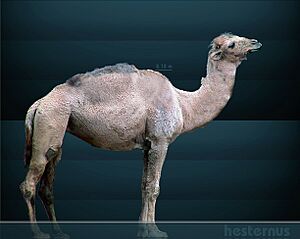 Life restoration of the Pliocene-Holocene camel Camelops
Life restoration of the Pliocene-Holocene camel Camelops - †Cuvieronius was another elephant relative. It had spiral tusks.
-
†Elaphe obsoleta is a type of rat snake. Its fossils show it lived here long ago.
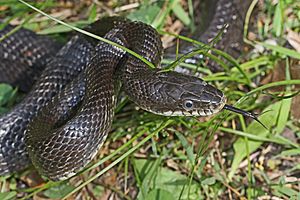 A living Pantherophis obsoletus, or black rat snake
A living Pantherophis obsoletus, or black rat snake - †Euceratherium was a type of ancient ox. It was called the "shrub ox."
- †Glyptotherium was a giant armadillo relative. It had a large, dome-shaped shell.
-
†Homotherium was a "scimitar cat." It had long, curved upper canine teeth.
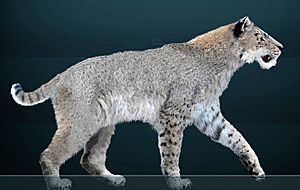 Restoration of Pliocene-Pleistocene Homotherium, or scimitar cat
Restoration of Pliocene-Pleistocene Homotherium, or scimitar cat - †Mammut was a mastodon. These were ancient elephant-like animals.
-
†Mammuthus columbi was the Columbian mammoth. These huge, hairy elephants roamed North America.
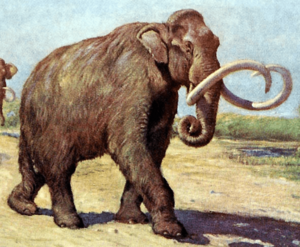 Life restoration of a herd of Mammuthus columbi, or Columbian mammoths. The extent of the fur depicted is hypothetical. Charles R. Knight (1909).
Life restoration of a herd of Mammuthus columbi, or Columbian mammoths. The extent of the fur depicted is hypothetical. Charles R. Knight (1909). - †Megalonyx was a giant ground sloth. It was as big as a bear.
- †Nannippus was a small, three-toed horse.
- †Nothrotheriops was another type of ground sloth.
- †Paramylodon was a large ground sloth.
-
†Platygonus was a type of ancient peccary. Peccaries are pig-like animals.
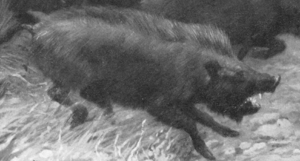 Restoration of a herd of alarmed Miocene-Pleistocene peccaries of the genus Platygonus. Charles R. Knight (1922).
Restoration of a herd of alarmed Miocene-Pleistocene peccaries of the genus Platygonus. Charles R. Knight (1922). -
†Smilodon was the famous saber-tooth cat. It had very long, sharp canine teeth.
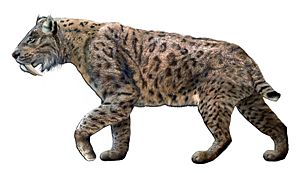 Life restoration of the Pleistocene-Holocene saber-tooth cat Smilodon
Life restoration of the Pleistocene-Holocene saber-tooth cat Smilodon - †Sthenictis was an ancient weasel.
- †Teleoceras was a short-legged rhinoceros. It lived in water, like a hippopotamus.
-
†Vulpes velox is the swift fox. Its fossils show it lived here in the past.
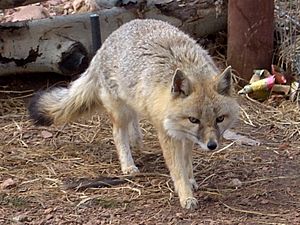 A living Vulpes velox, or swift fox
A living Vulpes velox, or swift fox


